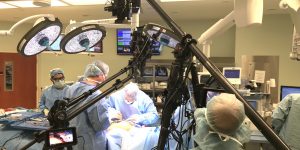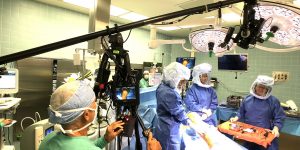Live Surgical Video
Live Surgery – Draw The Crowds
Live surgical video has an appeal that has been ongoing for decades now. Surgeon viewers especially like the directness and immediacy of the live surgical event. Whereas redundancy is typically edited out of the procedural video program, the live surgical event is an A to Z look at the presenting surgeon’s technique and thinking, right here and right now.
Shooting Surgical Video In The OR Live
Shooting in the OR live requires solid preparation and decisive planning. The demands for shooting a live event are much greater than capturing a surgical procedure and taking the footage to the editing suite. It necessitates more people, more cameras, and more equipment.
Teamwork And Maintaining The Conversation
Live surgical video demands teamwork and experience. It also requires that the floor director understands the nuances of the surgical procedure being broadcast, so that he knows the next shot required before the surgeon gets to that point. This is why it pays to have an experienced surgical video director, someone who knows surgery, and not just an average video director. Know the procedure and you know your shots.
Another component is that in the live OR event, it is essential to maintain and propel the conversation between surgeon and moderator. If the surgeon finds it challenging to fill the audio space while conducting surgery, it is sometimes advantageous to mic up an assisting surgeon or a roaming second surgeon in the OR, to ask questions or describe the procedure as it is occurring. Most frequently, the conversation between the surgeon in the OR and the moderator at show location will suffice, but options should be discussed during planning. There are many techniques that help sustain the interest of the audience, but the one essential component is to maintain the conversation as best as possible. We now live in the age of interaction, and simple on-looking has become somewhat passé.
Live Cadaveric Broadcasting
Plexus has broadcast many live cadaveric demonstrations and has a set of innovative techniques for live cadaveric lab presentations. Often multiple specimen stations are required so Plexus has devised a video camera configuration that contributes to the facile movement from station to station. We get involved in the lab management in order to make things happen like clockwork on shoot day. We may be asked to migrate from one station to another at a moment’s notice, so room configuration and planning are essential.
Types Of Video Transmission & Broadcasting
There are many ways to broadcast live or recorded video. For live events, transmission may involve anything from a simple station-to-station video and audio signal conveyance in a closed network to advanced broadcasting over multiple technologies and streams. Satellite uplink, ISDN and T1 line connections, closed circuit, intranet or Internet streaming are just some of the possibilities. Planning and requirements are of the essence with all live transmission.





